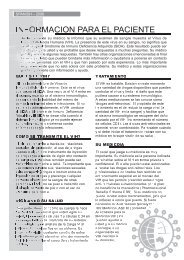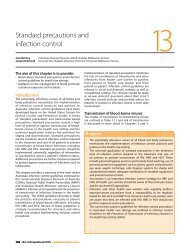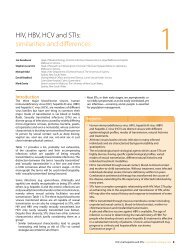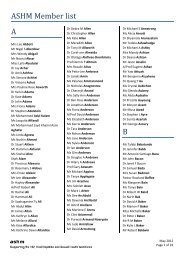B Positive – all you wanted to know about - ASHM
B Positive – all you wanted to know about - ASHM
B Positive – all you wanted to know about - ASHM
You also want an ePaper? Increase the reach of your titles
YUMPU automatically turns print PDFs into web optimized ePapers that Google loves.
� Extrahepatic manifestations of advanced<br />
liver disease<br />
� cirrhotic cardiomyopathy<br />
� Hepa<strong>to</strong>pulmonary syndromes<br />
� Hormonal complications<br />
- testicular atrophy and feminisation<br />
in men<br />
- hirsutism, amenorrhoea in women<br />
� increased risk of generalized infectious<br />
complications<br />
� Hepa<strong>to</strong>cellular carcinoma<br />
readers are referred <strong>to</strong> chapter 9: Hepatitis<br />
b virus-related hepa<strong>to</strong>cellular carcinoma and<br />
standard texts on liver disease for a more<br />
detailed description of this condition.<br />
Management strategies<br />
Management strategies should address <strong>all</strong> of<br />
the conditions identified above and strategies<br />
will need <strong>to</strong> be moni<strong>to</strong>red <strong>to</strong> assure treatment<br />
efficacy, <strong>to</strong> minimise complications and <strong>to</strong><br />
<strong>all</strong>ow changes <strong>to</strong> the management plan as the<br />
disease progresses or improves.<br />
Fluid and electrolyte problems are managed<br />
by:<br />
� restricting salt and water intake where<br />
necessary<br />
� ensuring electrolyte balance<br />
� cautious diuretic usage <strong>to</strong> minimise the<br />
risk of hepa<strong>to</strong>renal syndrome<br />
- spironolac<strong>to</strong>ne is the preferred agent,<br />
in doses from 25<strong>–</strong>400 mg per day<br />
- Low dose frusemide<br />
� Potassium supplements as necessary<br />
� a diet low in saturated fat with adequate<br />
protein, fruit and vegetables<br />
� Moni<strong>to</strong>ring progress with regular serum<br />
creatinine and urine electrolyte assays.<br />
When urine sodium f<strong>all</strong>s below 20 mmol/<br />
day, decreased renal perfusion is likely<br />
(reduce diuretic, consider saline infusion<br />
over one hour)<br />
� drainage of ascites may be necessary. in<br />
some patients this may need <strong>to</strong> become<br />
a regular process, as diuretics and other<br />
conservative management approaches often<br />
fail <strong>to</strong> control the problem. the procedure is<br />
described in standard texts. some patients<br />
are treated with transjugular intrahepatic<br />
por<strong>to</strong>systemic shunt (tiPs) <strong>to</strong> lower portal<br />
pressure and decrease ascites accumulation.<br />
� All patients presenting with ascites should<br />
have a diagnostic tap <strong>to</strong> exclude or diagnose<br />
spontaneous bacterial peri<strong>to</strong>nitis<br />
Portal hypertension is managed by:<br />
� <strong>all</strong> patients with newly diagnosed cirrhosis<br />
should undergo endoscopy <strong>to</strong> determine if<br />
varices are present<br />
� reducing hepatic inflammation when<br />
possible<br />
� Prophylactic<strong>all</strong>y modifying portal pressure<br />
with beta-blocking agents or nitrate therapy<br />
� banding oesophageal varices when they are<br />
identified<br />
� treating acute bleeding when it occurs<br />
� considering more active interventions if<br />
conservative measures fail<br />
� tiPs (transjugular, intrahepatic<br />
por<strong>to</strong>systemic shunts)<br />
� surgery for portal hypertension (rarely<br />
undertaken these days), which includes<br />
shunting procedures and oesophageal<br />
transection).<br />
Portal systemic encephalopathy is managed<br />
by:<br />
� regulating protein intake ensuring a<br />
reasonable intake <strong>to</strong> maintain nutritional<br />
status, while reducing <strong>to</strong>tal protein and<br />
animal protein<br />
� Maintaining optimal electrolyte balance<br />
� using lactulose <strong>to</strong> both clear the colon and<br />
alter ammonia metabolism and diffusion.<br />
use doses <strong>to</strong> ensure two soft s<strong>to</strong>ols per day<br />
and continue use long term<br />
� using neomycin and metronidazole short<br />
term if lactulose is not <strong>to</strong>lerated or if it is not<br />
effective. these agents also act <strong>to</strong> reduce<br />
ammonia levels, but they have significant<br />
side effects with long-term use<br />
agents such as L-dopa, bromocriptine, and<br />
branch chain amino acid solutions (oral<br />
and parenteral) have been tri<strong>all</strong>ed in portal<br />
systemic encephalopathy, but their efficacy is<br />
not proven.<br />
b <strong>Positive</strong> <strong>–</strong> <strong>all</strong> <strong>you</strong> <strong>wanted</strong> <strong>to</strong> <strong>know</strong> <strong>about</strong> hepatitis b: a guide for primary care providers 67






